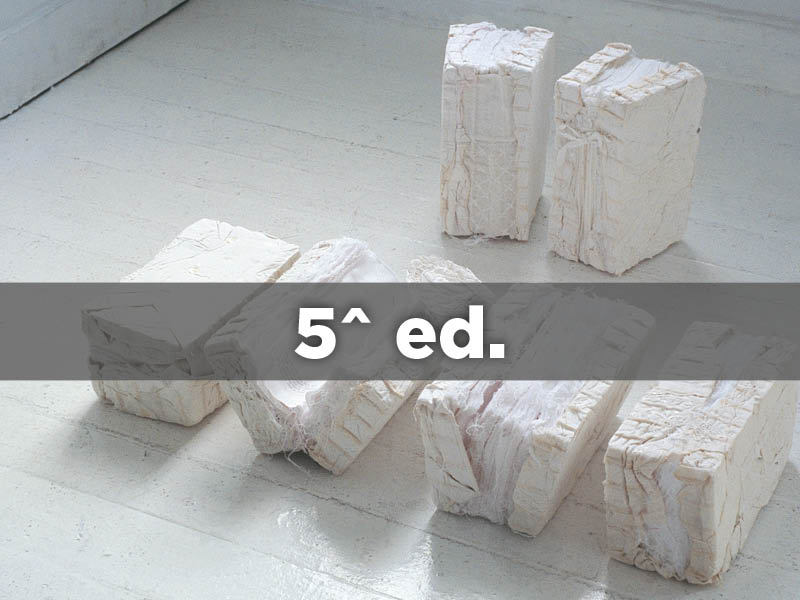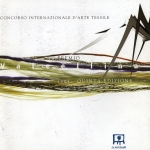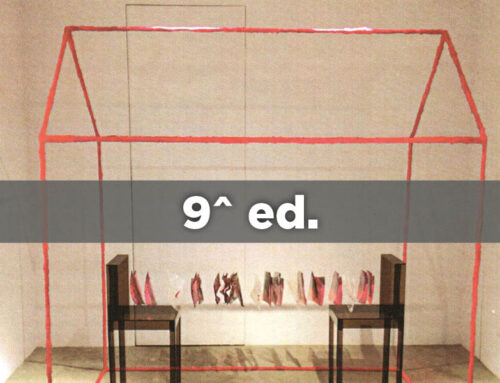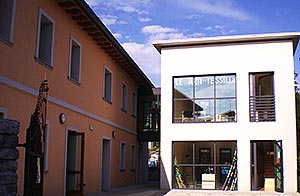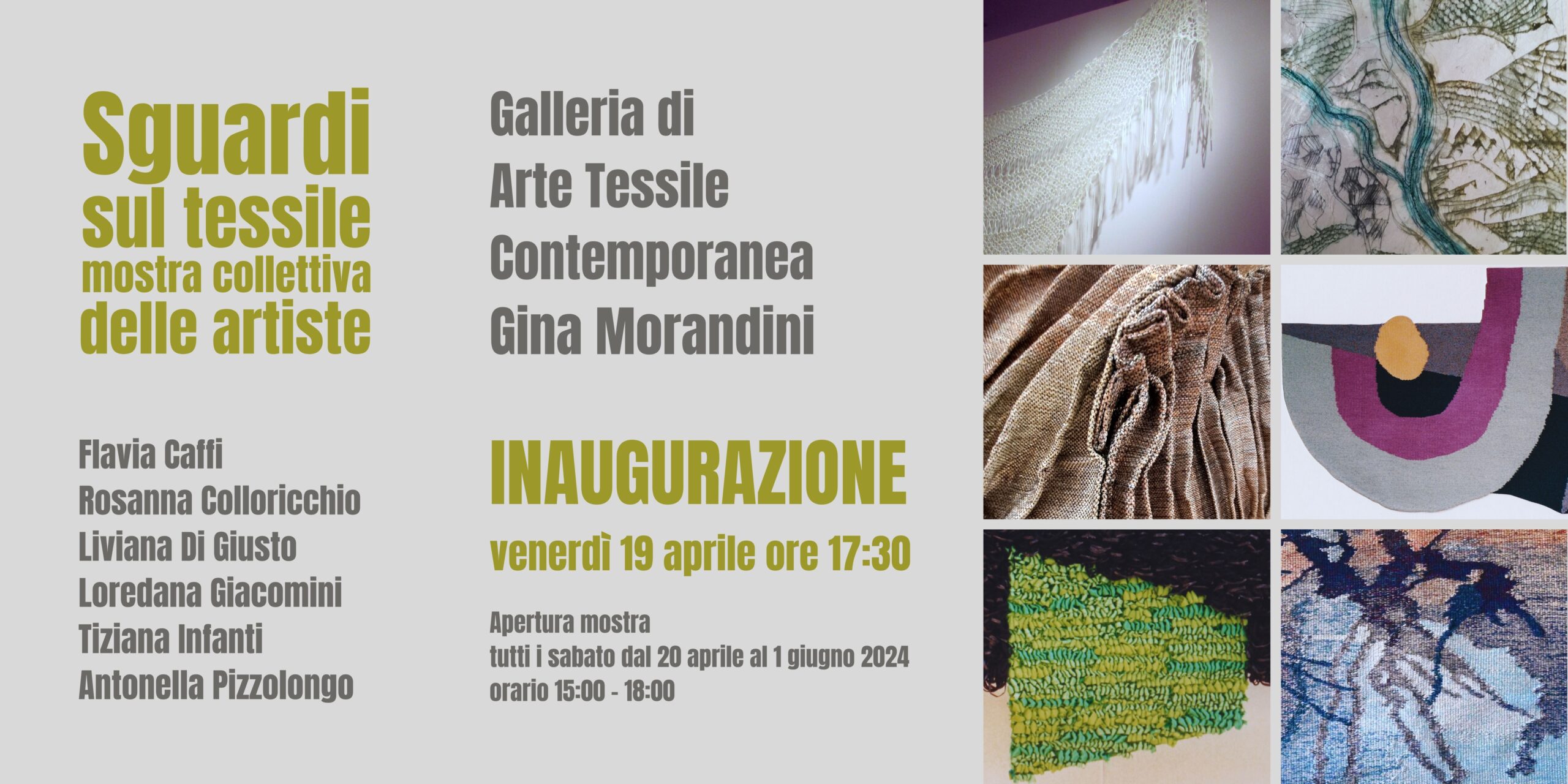2005-2006
Premio Valcellina, Concorso Internazionale d’Arte Tessile, 5^ edizione
Concorso aperto a tutti i giovani artisti tessili fino al compimento del 35° anno di età, nati dal 1 gennaio 1970
Valcellina Award, International Textile and Fiber Art Competition, 5th edition
Competition open to all young fiber artists under 35 years of age, born from 1st January 1970
Chiusura del bando 30 novembre 2005
Artisti 114 partecipanti, 47 selezionati ammessi al concorso
Inaugurazione e cerimonia di premiazione 1° aprile 2006, Museo CO.RI.CA.MA., Maniago PN
Durata dell’esposizione dal 2 aprile al 1° maggio 2006
Mostre collaterali
Over 35 [Oltre 35], opere degli artisti che, nelle passate edizioni, hanno fatto parte della giuria del Premio Valcellina: Carlo Ciussi, Vito Capone, Renate Maak, Gina Morandini, Maria Teresa Onofri, Lydia Predominato, Jorit Tornquist, Mimmo Totaro e Nane Zavagno. Luoghi espositivi in Maniago: Palazzo del Municipio, ingresso di Palazzo d’Attimis Maniago, Libreria Graff Libri, Galleria Linghéir, Teatro Comunale Giuseppe Verdi
4-spider [4-Ragni] installazione urbana di Massimo Marzinotto, Giorgio Marchese, Lorenzo Melzani e Lucia Vedovi, Museo CO.RI.CA.MA., Maniago
Eventi collaterali
Sfilata di abiti-scultura degli studenti dell’Accademia d’Alta Moda Koefia, Roma: Guscio di moda di Ilaria Baldazzi, Silvia De Santis e Elaham Majidi, Trucioli chic di Ilaria Carboni, Sara Di Salvo e Sara Fortunati, Fasce fashion di Elena Gagliardi, Maria Grazia Serra e Floriana Spinelli
Live Electronics (laptop, sampler, synthesizers) [Elettronica dal vivo (computer portatile, campionatore, sintetizzatori)] di Steve Nardini, Teatro Comunale Giuseppe Verdi, Maniago
Siamo in tante. Dizionario per un decennio, 1967 – 77, concerto teatrale, testi di Marina Giovanelli con Brigitta Bertolini, Claudia Grimaz e Nicoletta Oscuro, opere in scena di Gina Morandini, Teatro Comunale Giuseppe Verdi, Maniago
Deadline for participation 30 November 2005
Artists 114 participants, 47 selected and admitted to the competition
Inauguration and award cermony 1st April 2006, CO.RI.CA.MA. Museum, Maniago PN
Exposition period from 2nd April to 1st May 2006
Collateral exhibitions
Over 35, works of the artists who, in past editions, have been part of the jury of the Valcellina Award: Carlo Ciussi, Vito Capone, Renate Maak, Gina Morandini, Maria Teresa Onofri, Lydia Predominato, Jorit Tornquist, Mimmo Totaro and Nane Zavagno. Exhibition places in Maniago: Town hall Palace, entrance of Palazzo d’Attimis Maniago (d’Attimis Maniago Palace), Graff Libri bookshop, Linghéir Gallery, Giuseppe Verdi Municipal Theatre
4-spider urban installation by Massimo Marzinotto, Giorgio Marchese, Lorenzo Melzani and Lucia Vedovi, CO.RI.CA.MA. Museum, Maniago
Collateral events
Sculpture-clothes fashion show by the students of Accademia d’Alta Moda Koefia (High Fashion Academy Koefia), Rome: Guscio di moda (Fashion shell) by Ilaria Baldazzi, Silvia De Santis and Elaham Majidi, Trucioli chic (Chic shavings) by Ilaria Carboni, Sara Di Salvo and Sara Fortunati, Fasce fashion (Fashion strips) by Elena Gagliardi, Maria Grazia Serra and Floriana Spinelli
Live Electronics (laptop, sampler, synthesizers) by Steve Nardini, Giuseppe Verdi Municipal Theatre, Maniago
Siamo in tante. Dizionario per un decennio, 1967 – 77 (We are many. Dictionary for a decade, 1967 – 77), theatrical concert, texts by Marina Giovanelli with Brigitta Bertolini, Claudia Grimaz and Nicoletta Oscuro, works on stage by Gina Morandini, Giuseppe Verdi Municipal Theatre, Maniago
Giuria / Jury
Andrea Bruciati – Direttore della Galleria di Arte Contemporanea La Comunale, Monfalcone (GO) e critico d’arte / Director of the Contemporary Art Gallery La Comunale, Monfalcone (GO) and art critic
Anna Maria Teresa Bruni – Presidente Associazione Le Arti Tessili / President of Le Arti Tessili Association
Vito Capone – Artista / Artist
Carlo Clochiatti – Gallerista / Gallery owner
Maria Teresa Onofri – Artista / Artist
Renata Pompas – Giornalista, saggista e docente / Journalist, essayist and Teacher
Lydia Predominato – Fiber artista, ideatrice e curatrice di mostre di Fiber Art / Fiber artist, fiber art event maker and curator
Artisti selezionati, opere e premi assegnati
Selected artists, works and prizes awarded
PRIMO PREMIO / FIRST PRIZE
Naoko Yoshimoto (Giappone / Japan) La storia dietro gli indumenti / History behind clothes
SECONDO PREMIO / SECOND PRIZE
Alice Pontini (Italia / Italy) Sogno / Dream
TERZO PREMIO / THIRD PRIZE
Annett Erfurt (Germania / Germany) Legno / Wood
PREMIO SPECIALE / SPECIAL PRIZE FRIULI VENEZIA GIULIA
Alessia Del Vecchio (Italia / Italy) Guerra e Pace / War and peace
MENZIONE SPECIALE / SPECIAL MENTION
Justin Randolph Thompson (USA / USA) Trapunta / Quilt
Caterina Curzola e Elisa Scavazza (Italia / Italy) Developolaroid / Developolaroid
Claudia Kott & Marloes Jongen (Gernmania-Olanda / Germany-Holland) € 4,340 € 54,25 / € 4,340 € 54,25
Alicja Frąckowiak (Polonia / Poland) Senza titolo / Untitled
—
Sedef Acar (Turkia / Turkey) Giuria / Jury
Giuseppe Autiero (Italia / Italy) Como quieres vivir tu vida [Come vuoi vivere la tua vita] / How do you want to live your life
Danilo Busia (Italia / Italy) Cuscino da salotto / Lounge cushion
Carlotta Carzaniga (Italia / Italy) Radici / Roots
Lucia Cerri (Italia / Italy) Intreccio e seduzione / Interlacement and seduction
Daniela Costanzo Giorgio (Italia / Italy) Riconosci te stesso: il ballo della conoscenza / Recognize yourself: the ball of knowledge
Cristiana Di Nardo (Italia / Italy) Forme non geneticamente modificate / Forms not genetically modified
Gulcan Batur Ercivan (Turkia / Turkey) Concrezione / Clustered
Virginia Fabris (Italia / Italy) Faccia a faccia / Face to face
Elena Fregni (Italia / Italy) Senza titolo / Untitled
Touko Hayashi (Giappone / Japan) Ubur-ubur.2 -medusa- / Ubur-ubur.2 -jellyfish-
Aglaia Haritz (Svizzera – Switzerland) Nudi / Naked
Eva Holubíková (Slovacchia / Slovakia) Un grasso bidone della spazzatura / Fat trash bin foam padding
Andrea Kalteis (Austria / Austria) Artificiali / Artificials
Sunna Kangas (Finlandia / Finland) 2 soldati innamorati / 2 soldiers in love
Mika Kawamura (Giappone / Japan) L’erosione del silenzio / The erosion by silence
Zane Kokina (Lettonia / Latvia) Autoritratto / Selfportrait
Federica Luzzi (Italia / Italy) Conchiglia nera n. 5 / Black shell No. 5
Chieko Maeda (Giappone / Japan) Paio / Pair
Mariana Minke (Svizzera – Switzerland) Impronte / Prints
Firat Neziroglu (Turkia / Turkey) Questa è la mia vita / This is my life
Nadia Odorico (Italia / Italy) Dubbio / Doubt
Francesca Paolin (Italia / Italy) Tra cielo e fuoco / Between sky and fire
Megan Price (Canada / Canada) Prestopiùpresto / Fasterfaster
Elke Pűrgstaller (Austria / Austria) La finestra dei sogni / The window of dreams
Sophie Roet (Regno Unito / United Kingdom) Tessile di carta / Paper textile
Alessanra Ruo (Italia / Italy) Ossi di seta / Silk bones
Annette Sommer (Germania / Germany) Co-incidenze / Co-incidences
Manola Stefani (Italia / Italy) Tessere in libertà / Free weaving
Silvia Stella (Italia / Italy) Farenheit 45I / Farenheit 45I
Emma Streng (Olanda / Holland) Dentrofuori / Insideoutside suit
Sabine Teiner (Austria / Austria) Papavero rosso / Red poppy
Manuel Wandl (Austria / Austria) Ti guadagnerai il pane con il sudore della fronte, Genesi 3.19 / You’ll earn your living by the sweat of your brow, Genesis 3.19
Amayokasim Yamamoto (Giappone / Japan) Caos / Chaos
Ludwika Zytkiewicz (Polonia / Poland) Luce e ombra 3 / Light and shadow 3
Saggi critici / Critical essays
Quando nel 1921 Filippo Tommaso Marinetti registro l’interesse delle avanguardie artistiche del Novecento per la polimatericità nel “Manifesto del tattilismo”, descrisse visionarie camere materiche, realizzate con pavimenti e muri sensoriali. Non immaginava certo che, quasi mezzo secolo dopo, i fiber artisti avrebbero dato corpo alle sue visioni, realizzando le prime installazioni amnbientali tattili: come le famose stanze interamente avvolte da tessuto increspato, rosa pallido, della newyorkese Colette.
Dopo la rottura dei generi pittura/scultura e l’apertura alla sperimentazione di tecniche e materiali tra i piu eterogenei, fibra e tessuto sono entrati con prepotenza nel linguaggio artistico, a celebrare una polimatericità soffice e antiretorica. Diverse esperienze artistiche se ne sono avvalse: dal letto sfatto “Bed”, della pop-art di Rauschenberg, ai feltri dell’arte antropologica di Beuys, dalla “Venere degli stracci” dell’arte povera di Pistoletto, alle bambole concettuali di Louise Bourgeois e molto altro; ma c’e stato chi ha voluto privilegiare la specificità dei procedimenti e dei materiali della tessilità, scegliendo di indagarne le qualita espressive: è nato cosi, sul finire degli anni Sessanta, il movimento internazionale della Fiber Art.
Ora, da una decina di anni, anche i giovani che si affacciano sulla scena italiaria dell’arte sono invitati a prenderne coscienza e sono sollecitati a confrontarsi con il rnovimento, adottandone le caratteristiche.
E’ stato per merito di Gina Morandini, fiber artista e Presidente ad honorem dell’Associazione Nazionale Le Arti Tessili, e di Lydia Predominato, fiber artista e animatrice dell’arte tessile romana – che hanno creduto con tenacia e determinazione nella funzione didattica del Premio e nella strategica importanza della mostra per la sua visibilità nazionale e internazionale – che e stato istituito nel ’95 il Premio Valcellina, per opere di fiber art realizzate da autori entro i 35 anni di età, residenti in ltalia.
Oggi il Premio Valcellina é talmente cresciuto e si è cosi afferrnato da diventare un irnportante appuntarnento internazionale, che ha richiamato l’attenzione di artisti, critici d’arte, direttori di musei, galleristi e giornalisti.
Quest’anno ho avuto la gioia di partecipare alla giuria di questa edizione, che ha visionato 114 opere, provenienti da 18 paesi diversi, selezionandone 45 e attribuendo i premi e le menzioni speciali.
ll confronto tra giurati è stato particolarmente stimolante: ogni opera è stata analizzata con cura, ne sono state lette le motivazioni, si è discusso della loro pertinenza e aderenza alla contemporaneità dei linguaggi dell’arte; il confronto tra opinioni diverse ha messo in luce aspetti che potevano sfuggire ora all’uno, ora all’altro, e infine, con concordia di opinioni, si è deciso.
Mi sembra che le opere in mostra presentino un campionario interessante di quello che stanno facendo i giovani fiber artisti oggi: dalla video installazione al filo di ferro ritorto, dalla stampa fotografica al felting, dall’opera figurativa a quella concettuale.
Sono opere molto diverse – pur nella scelta comune di avvalersi di materiali e/o di procedimenti tessili – la cui varietà e poliedricità delle proposte riflettono la complessita della nostra società, in cui convivono piu linguaggi, piu aspirazioni, più visioni poetiche: espressione dell’instabilità e del forte mutamento che stiamo attraversando.
Oltre alle opere premiate, di cui sono state riportate le motivazioni nel verbale pubblicato in catalogo, mi piace soffermarmi, tra le altre, su “Clustered” della turca Gülcan Batur Ercivan, che ha applicato la paziente e complessa tecnica giapponese dello shibori per pieghettare e tingere moduli di tessuto bianco di seta, ricomposti in un lavoro di grande raffinatezza compositiva e cromatica, dove le parti non tinte creano un effetto di luce che attraversa la materia e si rifrange a caleidoscopio in mille frammenti tattili e ottici. “Intreccio e seduzione”, dell’italiana Lucia Cerri, che ha raccolto nei boschi elementi vegetali dai fusti flessibili, li ha resi malleabili con prolungate immersioni nell’acqua e li ha infine intessuti, sagomando l‘impronta di forrne imprecisate, come il ricordo di qualcosa che è stato coperto da questa rete profumata di campo e ora non c’é più. La giocosa giraffa che l’italiana Elena Fregni ha realizzato intrecciando filo di ferro brunito. Voglio concludere con il sorprendente e spiazzante “Cuscino da salotto”, dell’italiano Danilo Busia, che inserisce pazienternente su una rosea e morbida superficie di cera lucente, uno per uno ad anello, dei peli umani, secondo un andamento compositivo concentrico che crea l’immagine delicata di un fiore. Come ha scritto Jean Clair (2004): “se i peli, gli odori e gli umori sono ossessivamente respinti nella vita quotidiana, essi prosperano, nella maniera più vistosa, in quei momenti particolari che sono le manifestazioni artistiche”.
di Renata Pompas, giornalista, saggista e docente, giuria Premio Valcellina 5^ edizione
When in 1921 Filippo Tommaso Marinetti highlighted the 19″‘ century artistic avant-gardes’ interest in mixed media in his “Manifesto of Tactilism”, he described visionary material chambers made of sensory floors and walls. He certainly did not imagine that, almost half a century later, fiber artists would make his visions become true by creating the first environmental tactile installations like the famous chambers completely covered with pale pink crepe fabric of New Yorker Colette.
After the rupture of painting, and sculpture’s boundaries and the possibility to experiment with the most different materials and techniques, fiber and fabric forcefully became part of the artistic idiom, and consequently celebrated a soft and antirethoric mixed media dimension. Various artistic trends made reference to it: from the undone “Bed” of Rauscheberg’s pop art, to the felts of Beuys’ anthropological art, from “Venus of Rags” of Pistoletto’s arte povera, to Louise Bourgeois’ conceptual dolls, and so on.
However, there were some artists who had the priviledge to explore the specific qualities of textile processes and materials, and chose to investigate their expressive qualitites. As a result, Fiber Art’s international movement saw the light at the end of the sixties of last century.
In these last ten years also the youth who tread the Italian artistic scene are invited to become aware of the movement, face its challenges, and focus on its specific characteristics. It must be credited to Gina Morandini, fiber artist and Honorary President of Le Arti Tessili Association, and Lydia Predominato, fiber artist and textile event maker in the Roman area – who have tenaciously and determinatedly believed in the didactic function of the Award and in the strategic importance of the Award exhibition as a national and international forum – the merit of establishing the Valcellina Award in 1996 for fiber art works made by artists under 35 years of age, residing in Italy.
Nowadays, the Award has grown and become renown in such a way that it has turned into an international event of paramount importance attracting the attention of artists, art critics, museum directors, gallery owners, and journalists.
To my great joy, this year I have participated in the jury of this edition. We have examined 114 works coming from 18 different countries, selected 45, and then assigned the prizes and honorable mentions.
Confrontation among jury members was rather stimulating: each oeuvre was carefully inspected, the artists’ motivations were read, and the jurors discussed about the relevance and pertinence of the works with regard to contemporary art idioms. Confrontation between the different opinions of the jurors has highlighted the various aspects they might otherwise overlook. Final decisions were made in full harmony.
In my opinion, the works on show offer an interesting sampling of what the young fiber artists do now: from video installation to twisted wire, from photographic print to felting, from pictorial to conceptual oeuvres. All works are very different although the general approach is that of using textile materials and-or adopting textile processes.
In fact, the variety and versatility of the works reflect the complexity of our society where many idioms, aspirations, and poetical visions coexist – a clear sign of the instability and disrupting changes we experience in our days. Besides the prized works, whose motivations are shown in the minutes published in the catalogue, I would like to cite, among others, the Turkish artist Gülcan Batur Ercivan’s “Clustered”. She has used the painstaking and complex Japanese technique to pleat and dye modules of white silk re-arranging them in a final work of great compositive and chromatic refinement. The non-dyed parts create a light effect which goes through the matter and refracts countless tactile and optical fragments in a kaleidoskopic effect.
“Interlacement and Seduction” of the Italian artist Lucia Cerri, who has gathered vegetal flexible elements in the woods, has made them malleable through repeated immersions into the water, and then woven them with marks of uncertain forms – achieving almost the remembrance of something which was covered with this field-scented net, and now no longer exists. I will also note the funny giraffe which the Italian artist Elena Fregni has created by interlacing burnished wire. I want to conclude with the surprisingly unexpected “Lounge Cushion” of the Italian artist Danilo Busia who has patiently inserted human hairs one by one ringwise into a soft pinkish glowing waxed surface according to a concentric composed design which creates a delicate image of a flower.
As Jean Clair wrote (2OO4): “If hairs, odors, and humors are obsessively rejected in our daily life, they however thrift, in the most capturing manner, in those particular moments which are the artistic events.”
by Renata Pompas, journalist, essayist and teacher, jury member of Valcellina Award 5th edition
Dalla caduta del Muro di Berlino (1989), il panorama dell’arte contemporanea si è problematicizzato, lasciando emergere un diverso interesse nei confronti della realtà, della dimensione volta al presente. A manifestarsi è stata una sensibilità più sottile verso il quotidiano, che ha accentuato l’attenzione nei confronti della narrazione degli eventi, del fatto di cronaca e, di converso, a tutto ciò che risulta immediatamente vicino alla sfera individuale. Tale orientamento ha condotto alla riscoperta di una dimensione intima che tenesse conto anche di una sfera più direttamente rivolta all’aspetto sociale. In questa accezione, nella riflessione sul dato “storico” anche il corpo ritorna ad essere un luogo di indagine, poichè luogo della diversità, incarnazione biologica delle differenze specifiche dei soggetti, deposito della memoria culturale.
Anche per tali connotazioni, negli anni novanta, una sensibilità al femminile è pertanto risultata più rispondente alle nuove esigenze di cura, attenzione e ricostruzione del simbolo, al fine di costruire un rinnovato paradigma etico per una comunità, un individuo che in maniera critica e consapevole si stava accingendo al passaggio verso il nuovo millennio.
Questa differente sensibilità, certo ora non più prerogativa di un’unica categoria sessuale, ha permesso un recupero di fattori, sinora ritenuti marginali per la speculazione artistica: ha cioè consentito una indagine su parametri ‘emotivi’, che potessero ribadire, da un punto di vista metodologico, un’alternativa chiave di lettura. Nell’esigenza di partire da un portato personale e da una prospettiva nel contempo ralazionale, nell’attenzione riservata al fattore temporale, nonchè nell’uso rilevante di una dimensione narrativa, si è così pervenuti alla riscoperta in funzione estetica di materiali prima sviliti in quanto ritenuti artigianali e refrattari, a pratiche popolari di lavoro che ribadissero, con la loro lenta e complessa articolazione, un modus operandi nuovo in quanto antico. Si comprende pertanto come anche la lavorazione del tessile, sia per i materiali “versatili”, e maneggievoli che per le pratiche di intervento, che recuperano una pratica processuale di elaborazione, sia divenuta variante sintomatica spesso imprescindibile, centrale nella speculazione degli autori operanti nelle arti visive delle ultime generazioni. Gli interventi di Ghada Amer, Maja Bajevic, Wim Delvoye, Tracey Emin, Mona Hatoum, Eva Marisaldi, Rosemarie Trockel, Francesco Vezzoli, sono ormai esempi autoriali da cui i giovani, che vogliono accedere al sistema dell’arte contemporanea, non possono più esimersi.
Nei progetti pervenuti per questa selezione, a mio avviso, due sono pertanto sembrati i campi di indagine conseguenti al profilo di orientamento appena delineato, aree ancora capaci di ridefinizione linguistca e speculazione da parte degli artisti, coerentemente all’impirego di materiali precipui alla fiber art.
La dimensione narrativa e sociale da un lato e un’indagine sulla forma sculrorea, organica, rappresentano dunque, un binomio innternazionale che ha sensibilmente connotato le opere dei giovani, nati fra il 1979 e il 1982, almeno tra coloro che mi sono apparsi più vigili nel sondare le problematiche estetiche connesse al contemporaneo.
Fra 45 progetti selezionari, segnalo questo breve elenco, una lista costituita da sette promesse. Si tratta degli emergenti: Claudia Kott / Germania 1982 e Marloes Jongen / Paesi Bassi 1979 €4,340 / € 54,25 (2005): attraverso la presentazione/esposizione di logore vesti un tempo preziose, i due abitini aprono una riflessione di ordine sociale soffermandosi sul diverso prezzo di acquisto, il differente valore della merce e del suo costo di realizzazione, nei paesi occidentali e nel terzo mondo.
Eva Holubìková / Rep. Slovacca 1979 Fat trash Bin (2005): col suo intervento non riveste ma ingloba, come una scultura, con un contenitore dei rifiuti. Un’operazione da un lato ribadisce la peculiarità manifatturiera dell’arte tessile, l’impiego al servizio della comunità, mentre dall’altro viene verificata l’installazione quale esempio di public art.
Emma Streng / Paesi Bassi 1980 Inside Outside Suit (2005): la speculazione riguarda il concetto di abito involucro, seconda pelle, disgiunto da qualsiasi valore simbolico e sociale. Le cuciture e i colori, modellati su di un manichino algido e impersonale, conferiscono straniamento ad un involucro tecnologico.
Manuel Wandl / Austria 1980 Im Schweíße deines Augesichts sollst du dein Brot essen, Genesis 3.19 (Ti guadagnerai il pane con il sudore della fronte. Genesi 3,19) (2005): il versetto della Bibbia, rivela l’ambiguità del messaggio e della parola scritta, qui ricamata come nelle pratiche artigianali legate alle produzioni popolari alpine.
Chieko Maeda / Giapporie 1981 Pair (2005): la materia si fa fitomorfica, una sorta di baccello primordiale di materiale grezzo, dove le fibre della stoffa rimaridano a filamenti organici.
Alicja Frąckowiak / Polonia 1980 Untitled (2005): una leggerezza di intervento che si espleta nell’accostamento di pezze di tessuto unite da orditure fragili e precarie, simbolo di una caducità e debolezza peculiare nell’intervenire odierno nel reale.
di Andrea Bruciati, storico dell’arte, direttore della Galleria d’Arte Contemporanea La Comunale di Monfalcone GO, giuria Premio Valcellina 5^ edizione
Since the fall of the Berlin Wall (1989), the panorama of contemporary art has become more and more problematic, allowing a different interest towards reality, i. e., and the present dimension. A subtler sensitive approach toward everyday life has risen, which has stressed the attention towards the narration of events, news items, and conversely towards all which is immediately near each individual sphere. Such orientation has led to the rediscovery of an initimate dimension which at the same time encompasses the social aspect more directly. In this regard, when reflecting on the historical data, the body once again becomes a research matter, as the place of different qualities, bioloIgical embodiment of the specific differences of the various subjects, a depot of cultural memories. On the basis of these connotations, in the nineties of the last century, a feminine sensitivity has therefore resulted more appropriate for the new curation needs, considering, and rebuilding, symbols with the purpose of establishing a renovated ethic paradigm for the community, i.e., individuals who in a critic and conscious manner were approaching the passage towards the new millenium.
This different sensitivity, now no longer a characteristic of only one sexual category, has allowed the recovering of various factors which were considered marginal in artistic speculation: in other words, it has made it possible to carry on a survey based on “emotional” parameters which could stress the importance of an alternative key to the reading from a methodological point of view. The need was felt starting from both a personal standpoint and simultaneously a relational approach, at the same time keeping in mind the time factor and the relevant use of narration. In this way, an aesthetic approach has rediscovered materials that were underrated since they were considered insensitive and belonging to the handicraft, and popular work techniques which, thanks to their slow and complex articulation, could highlight a new however ancient ‘modus operandi’.
We therefore understand how textiles, both due to their ‘versatile’ and handy materials, qualities, and the technical approach involved which reaffirms a practical process, have become a symptomatic often unavoidable variant of great focus in the speculation of the latest generations of visual artists. Interventions by Ghada Amer, Maja Bajevic, Wim Delvoye, Trace Emin, Mona Hatoum, Eva Marisaldi, Rosemair Trockel, Francesco Vezzoli are by now authoritative examples which the young artists who intend to enter into the contemporary art system, cannot ignore. Going through the projects submitted for this selection, l can spot two different areas coherent with what was outlined above. They are areas which can undergo a linguistic redefinition and speculation on the part of the participating artists on the basis of the use of fiber art materials employed. The narrative and social dimension on one side and a critical consideration of the sculptural and organic form represent a binomial intention which has deeply connotated the works of those young, artists, born between 1979 and 1982, who have seemed to me to be most attentive in questioning the aesthetic problems connected with the contemporary situation.
Among the 45 selected projects, l would propose this brief list of seven rising stars. Claudia Kott, Germany, born in 1982 and Marloes Jongen, The Netherland, born in 1979 €4,340 / € 54,25 (2005): by showing worn-out previously precious garments, the two short tunics induce reflections of social order by focusing on the different retail prices, the different merchandise value, and the production cost in Western countries and the underdeveloped world.
Eva Holubìková, Slovak Republic, born in 1979 Fat Trash Bin (2005): Eva does not cover but instead englobes a trash bin, and makes it into a sculpture. On one side, her intervention stresses the manufactuiring peculiarity of textile art, and the use of the object dedicated to the community, on the other the installation becomes an example of public art.
Emma Streng, The Netherlands, born in 1980 lnsideour Suit (2005): her speculation considers the concept of cocoon-dress, almost a second skin, separated from any symbolic and social value. The seams and colors, modelled on an algid and impersonal mannequin, confer an estranged effect to a technological container.
Manuel Wandl, Austria, born in 1980 Im Schweíße deines Augesichts sollst du dein Brot essen, Genesis 3.19 (You’ll earn your living by the sweat of your brow, Genesis 3.19) (2005): the Bible verse reveals the ambiguity of the message and written word which is embroidered in his work like in the Alpine popular handicraft manufacts.
Chieko Maeda, Japan, born in 1981 Pair (2005): matter becomes phitornorphic, a kind of primeval hull of raw material where the fabric fibers recall organic filaments.
Alicja Frackowiak, Poland, born in 1980 Untitled (2005): hers is a light intervention which lines fabric pieces decorated with some fragile and precarious woven insertions, meant to be symbols of frailty and weakness, peculiar to the contemporary approach to reality.
by Andrea Bruciati, art historian, director of the Contemporary Art Gallery La Comunale, Monfalcone GO, jury member of Valcellina Award 5th edition

